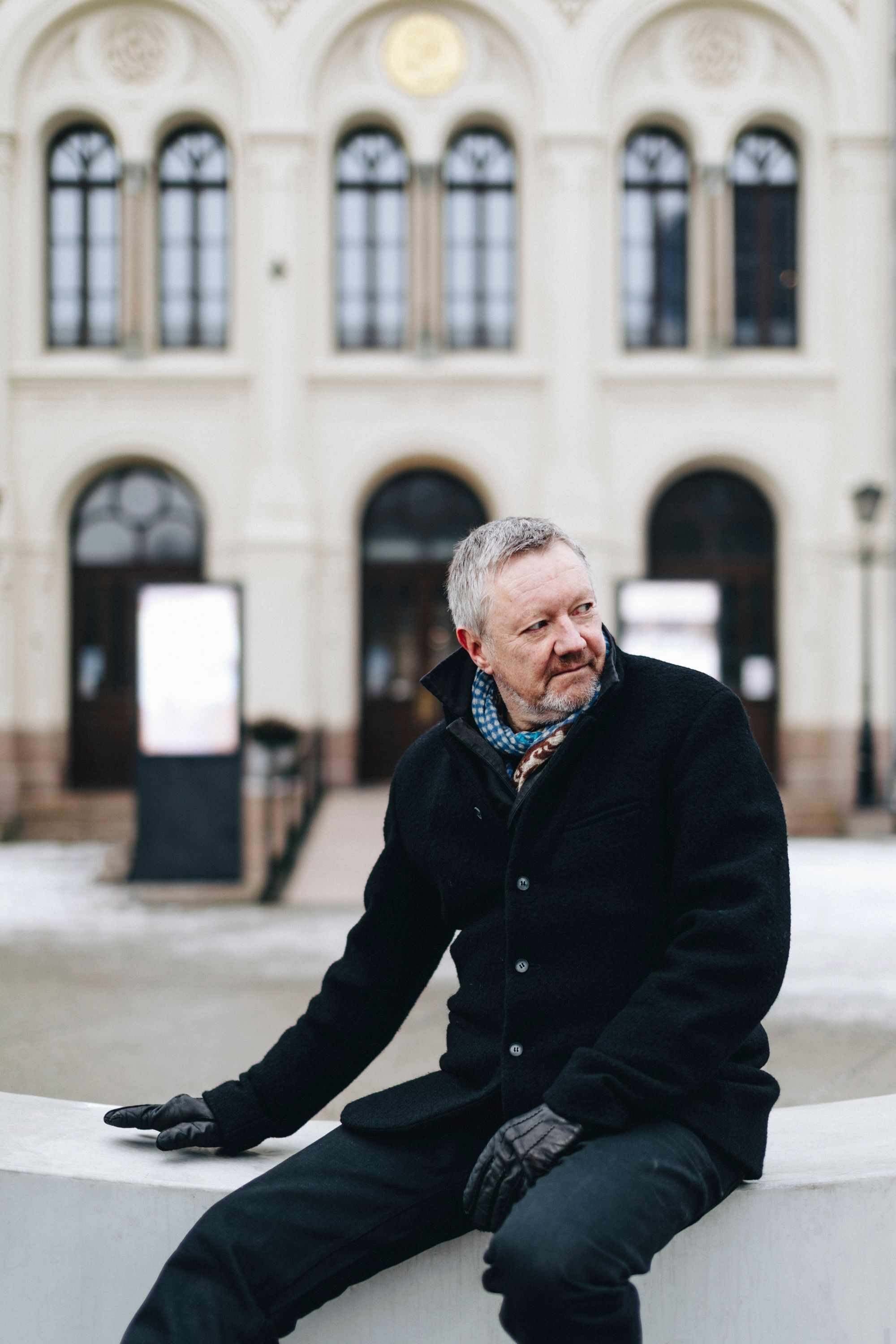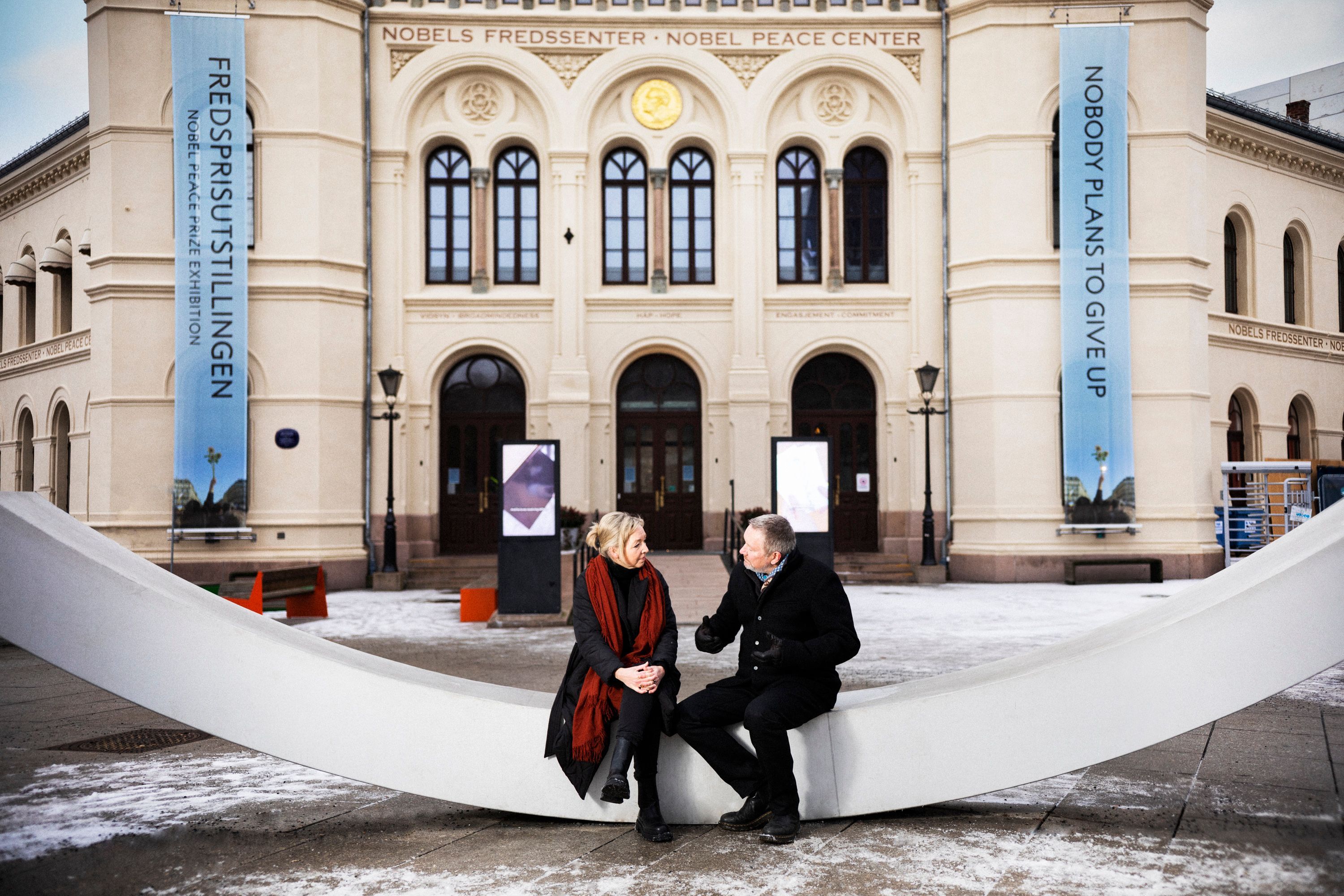- START THE DIALOGUE BY FINDING SIMILARITIES INSTEAD OF DIFFERENCES
Kjetil Trædal Thorsen, the founder of Snøhetta, spent nearly a year sipping lemon cordial in an Egyptian waiting room, an experience that imparted a valuable lesson about the art of dialogue.
Right in front of the Nobel Peace Center in Oslo, on the big open square towards the City Hall, there is a special bench. It looks like a smile, a banana, a swing, a seesaw- or perhaps something else entirely.
Regardless of interpretation: If you sit down on the bench, you will slide down towards the middle. If you're lucky, there will be someone sitting next to you who is making the exact same journey. Gravity is hard to argue against.
The same, we feel, about the Nelson Mandela quote engraved on the installation: "The best weapon is to sit down and talk".
And this brings us to the core of Snøhetta's modus operandi, according to the company's founder Kjetil Trædal Thorsen, who has settled down on the bench.
- We are all on the same planet, we can't seem to do anything about that. Creating a bench that works with gravity to bring people together, I think is a nice translation of this simple fact. In many ways, this bench is a summary of many things in one very simple object.
KJETIL TRÆDAL THORSEN'S TOP FIVE TIPS FOR A BETTER DIALOGUE:
1. Listen!
You can't have a proper conversation if you always speak first. So, listening in a dialogue-based conversation is extremely important.
2. Have plenty of time
It takes time to establish the long-term dialogue – the one that isn't over after an hour-long meeting, where you think you've got everything sorted. In dialogue, you may have to sit and drink tea for two hours before reaching the subject you want to discuss. And you must consider it as a continuous work.
3. Look for similarities
Start the dialogue by finding similarities rather than differences. That way, you may be able to build a greater understanding and tolerance for the differences when you get there.
4. Identify your dialogue partner
Remember that the person you have a dialogue with is not always the person sitting opposite you at the table. The person you are talking to might represent an entire group that is not present - someone out there that you don't know at all.
5. Keep the internal dialogue going
It is important that people constantly understand why they do what they do. Within your own company or organisation, keep working with the value-based content surrounding your company culture and structure in the form of dialogue.
Opens up oppertunities internationally
A few days earlier, Kjetil invites to a conversation at Snøhetta's headquarters on Vippetangen, where the Oslofjord is making a half-hearted attempt to freeze into ice.
Kjetil co-founded Snøhetta in 1987, and after 35 years, the company has achieved remarkable international success. One would need to be remarkably disengaged from Norwegian architecture and design not to hold a deep admiration for Kjetil and his team's outstanding accomplishments, both on a national scale, like Oslo's iconic opera house, and on an international level, exemplified by the library in Alexandria, Egypt.
But what does dialogue mean in practice for Snøhetta? Is dialogue good for business? And what tricks does Kjetil have up his sleeve to create a a good dialogue?
- A significant part of what we are doing is constantly entering into some kind of negotiation situation. Dialogue and conversation-based solutions have been a great help to open up the opportunities we get internationally, says Kjetil.
A negotiated architecture
As an international player working on large and complex projects, dialogue is alpha and omega for Snøhetta.
One of the most difficult dialogue situations the firm has embarked on is the work on the memorial pavilion at Ground Zero in New York, which was completed ten years after the twin towers collapsed on September 11, 2001. In that project we had to negotiate the requests and demands of a lot of different voices, and in such a situation, naturally there are some trade-offs that must be made

- Everyone who was affected was, in a way, against each other. The firefighters did not fully agree with the police officers about how the rescue work had been carried out. The Muslims did not agree with the Christians, the Catholics did not agree with the Protestants, the Republicans did not agree with the Democrats. Everyone was in a sort of vacuum of viewpoints on how the memorial pavilion should look like.
The solution was setting up meetings with up to 300 people in one room, where everyone basically disagreed. Through conversations and often conflicting proposals, slowly but surely an outline of a consensus gradually formed. The process was deftly managed by Snøhetta co-founder Craig Dykers.
- From the first day, we said that what we are doing here is a negotiated architecture. The very concept itself was the negotiation, the dialogue, the agreement.
Kjetil points to an example from his home country that underlines the important role time plays in being able to establish a meaningful dialogue.
- Look at the discussions we have had around the re-construction of the government headquarter in Oslo, a building that was severely damaged in the terror attacks on July 22, 2011. It is often not possible to decide on these big decisions too soon after the course of such terrible events. You often need the passing of time to be able to process such an extreme situation. However, during that period, it is important to maintain the dialogue, because it helps to bring about change.
The dialogue that continues
The necessity of dialogue became obvious to Kjetil and the rest of Snøhetta when they won their first major international competition in 1989 – the library in Alexandria, a projcet that was only completed in 2001.
With UNESCO as the driving force behind the project, Snøhettaenteredintoa four-party collaboration with the UN organisation, Egypt authorities and the international community.
- The parties had to be in a continuous dialogue throughout this long proess - not only to secure the house, but to ensure the future operation of the house when it was finished, and to ensure that the intentions and motivation for building the house at were maintained though social and political circumstances changed. So, the dialogue has continued long after the actual work was finished.
In practice, the process concerning the library in Alexandria involved several things. One of them was about the right of determination. Snøhetta decided that the construction should take place in a 50/50 collaboration between Egyptian companies and foreign expertise.
- We gave the contractors and the authorities the task of negotiating their agreement on the delivery. For instance, the great stone wall around the library – it was built with 50 percent Egyptian and 50 percent Turkish effort. Initially, tensions were high as normally these two countriesdo not necessarily get along very well. But it turned out that by forcing such a 50/50 situation, they continued the collaboration even after the project finished.
Kjetil himself sat every day for almost a year in the waiting room to the office of the minister of education in Egypt drinking lemon cordial.
- Every day I came in, he said "unfortunately, it doesn't work today". And the next day: "No, it doesn’t work today either." But when you first enter into dialogue, you can use the advantage of having patience, says Kjetil.
- Without the dialogue on our part, with actually moving 14 people in our team to Cairo, being there on the ground, and keeping up the dialogue every day with the engineers, with the client, with the Ministry of Education and with contractors on the construction site, we would not have been able to realise the project. You must be there and be present. .
"From the first day, we said that what we are doing here is a negotiated architecture. The concept itself was the negotiation, the dialogue, the agreement."
Similarities and differences
Even though Snøhetta has worked with great success with a dialogue-based approach for years, surely there must have been situations where the conversation falters and a common consensus slips further and further away?
Of course, assures Kjetil. At the same time, he points to a paradoxical aspect of dialogue:
- Where the dialogue often falls short is where we have assumed that we most in common. Where we initially assumed that there are greater cultural differences, it is often easier to gain understanding for a dialogue-based process than between two Norwegians that think they think alike.
Where the cultural differences are significant, it is essential to start by finding out what you have in common.
- If we agree on our commonalities, we have a greater understanding of the differences as they emerge. That way we can also gradually become more and more firm in our own positions. Dialogue does not mean that we should renounce what we stand for and what we want to achieve.
Idealism and profitability
According to Kjetil Trædal Thorsen, Snøhetta spent more than 30 years before they started making a profit. He believes business in Norway has should learn to be more patient.
- It's no use thinking that if we don't make money after three years, we should give up. In our industry that would be fatal - we hadn't managed to build a single house in three years. Having a long-term perspective is integral to working in architecture. You have to be patient financially.
Maintaining the commitment and idealism of everyone who works at Snøhetta - not only in the Oslo office, but in New York, San Francisco, Adelaide, Innsbruck, Paris and Hong Kong, as well as the two newly established studios in Melbourne and Shenzhen - is bottom line in everything we do.
Kjetil looks out of the large window from the office at Vippetangen.
- All my colleagues sitting out here in this room must feel that there is a meaning behind what they are doing. They are all idealists. They want to change the world. That is why they study architecture and design. They want to contribute positively. Not just to create beautiful things, although the joy of design and aesthetics are part of that, he says.
- But the most important thing, I believe, is how we as architects can help influence the environmental issue and engage in social sustainability. Can we be part of the solution to these problems? That is what we aim for in our work.

Hedvig Montgomery
Hedvig Montgomery believes that our ability to communicate improves with each new generation. However, there's one modern phrase that particularly irks the psychologist.

Deeyah Khan
The filmmaker Deeyah Khan has portrayed right-wing extremists, violent spouses, abortion opponents and jihadists. According to herself, the key to her work is curiosity.

Gina Gylver
Gina Gylver serves as the leader of Nature and Youth – Young Friends of the Earth (NU). In her activism, dialogue stands out as one of her most fundamental and frequently employed tools.
Learn more about dialogue
Go to our dialogue ressources, find our toolbox for dialogue and our interactive dialogue film.


